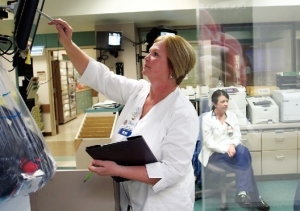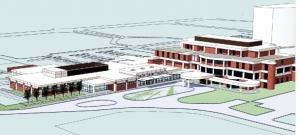Hospital moves ahead with ER expansion plan
By Phyllis Moore
Published in News on March 24, 2011 1:46 PM

News-Argus/MICHAEL BETTS
Registered nurse Lori Brock checks a patient's chart by using a touch screen computer at the nurses' station in Wayne Memorial Hospital's emergency room. Officials are planning an expansion of the emergency room that would triple the size of its current space to about 35,000 square feet. The $18 million project is expected to take about a year to complete.

Submitted photo
An artist's rendering of the proposed expansion to the emergency department at Wayne Memorial Hospital. The 35,000-square-foot addition will more than triple the existing space. The $18 million project is expected to take one year to complete.
The Emergency Department at Wayne Memorial Hospital has been bursting at the seams for nearly a decade.
When the West Wing was built in 1991, the Emergency Room was designed for a capacity of about 35,000 visits a year, said Tom Bradshaw, vice president of operations.
It's now posting closer to 55,000 patient visits a year.
"We have essentially doubled the volume," he said.
It's a trend not uncommon around the country, he said. Even with anticipated changes in health care reform, there is a continuation of growth and utilization of emergency rooms, he said.
Expanding the premises at Wayne Memorial has been a discussion topic for some time, with the hospital's board voting at its recent meeting to move ahead with plans that will more than triple the current space from 11,000 square feet to 35,000 square feet. It will also increase the number of patient beds, from 22 to 42, plus four psychiatric beds.
The $18 million project is expected to take one year, with completion targeted for June 2012, Bradshaw said.
"The good part of this project is it essentially builds a whole new wing on the existing ER," he said.
Joe DePalantino, administrative director of support services, has been working closely with the nursing and medical staffs as well as the architects on the design of the project.
Certainly, there will be a level of disruption during the construction effort, but for the public, that will only be minimal, the officials said.
"The only inconvenience for those coming in, the driving will have to be shifted toward the back, toward the side a little bit," Bradshaw said.
And once complete, he added, the area will be adequately marked so patients will know where to go.
No new parking spaces are being added in the initial phase, DePalantino said, although space for additional parking has been identified to meet future demand. The helicopter pad will also be temporarily moved to accommodate construction.
A decision about future use of the existing facility has not been made, officials say, but it will definitely not go to waste.
"We have some ideas," Bradshaw said. "We certainly need some space, but we really haven't gotten there. It's a question of which services would be the best use of that space."
The most important thing is that everyone who comes in for treatment receives it.
"One of our major concerns is people who come that leave without being seen," he said. "They just give up and go home or go somewhere else.
"Built into this (plan) is what we're calling fast track, for those who are not emergent, because there are people who come and need to be seen but they're not in the category of heart attack or the fracture or stroke, motor vehicle accident or trauma, but they do need to be seen."
It's an issue those in the nursing field have long dealt with -- access to care and seeing patients in a timely manner.
"Our belief is that people come to the ER because they want to be seen quickly," said Shirley Harkey, vice president patient services. "They have gotten sick at work and they can't get an appointment or they don't want to wait for an appointment and want to be seen and they want something done right now.
"They come to the ER not because they can't pay but because they want instant treatment."
That doesn't always happen, as in the case where others arrive at the Emergency Department with a higher degree of urgency.
When a patient leaves the premises without being treated, though, there is no way of knowing how severe the problem might have been, which creates frustration and dissatisfaction that might or might not be legitimate.
"Sometimes their expectations for care in the ER may not be met because their expectations don't match up to what the physicians or the nurse think is the best course," Mrs. Harkey said. "In the ER, the doctors and nurses have got to know when to go fast or when we need to go slow because we have got to do some tests or we have got to figure this out."
The decision to expand the Emergency Department could benefit not only the growing number of patrons but also the staff.
The added floor space, as well as the layout -- designed to create a more open viewing area for nurses -- will be especially helpful.
"I think they won't be as worried about what's going on in the waiting room because you'll have the visibility to the waiting room," said Donna Wimberly, assistant vice president for nursing. "If we can see more people at the same time, then it's not as likely that someone is going to be waiting and not see their condition change.
"That's the fear of ED nurses nationally -- that (patients are) going to be getting worse and you're not there to do something about it."
Staffing will also be adjusted accordingly, with the potential for new hires imminent, Mrs. Harkey said.
"Our goal is hopefully with this, because we have built this in such a way there actually will be a PA (physician's assistant) and minor things he can take care of immediately, we hope that people will not leave," said Denise Bruce, director of the emergency department. "They came here because they wanted care. My biggest concern here as a director has been people that leave.
"My goal is that we want to decrease our left-without-being-seen (numbers), hopefully stop that by meeting the needs of the community."
The plans for the proposed expansion project have gone relatively smoothly, said Mrs. Harkey, who credited two physicians with supporting the effort -- Dr. Terry Grant, president of Goldsboro Emergency Medicine, a physician practice that provides medical services for the Emergency Department, and Dr. Lloyd Smith, medical director at the hospital.
"They spent countless hours helping us figure out what we needed, how we plan to have better access for our trauma," Ms. Bruce said. "We have always done triage, sorting of patients so that you get seen as best as we know your level of criticality."
When construction begins later this spring, it will be the culmination of nearly two years' worth of work, said Ms. Wimberly, part of a group that visited newer nursing departments in North and South Carolina hospitals to pull together ideas of best practices.
"It's going to be pretty state-of-the-art," she said. "Four big trauma rooms, for example. Instead of having a lot of equipment in the room, we'll have this common corridor that stores all your equipment. Every room has immediate access, too, but without restricting (staff)."
If growth continues as it is, there will likely be the need to expand again in another 10 years, so the current project is by no means extravagant, officials said.
"We want to provide the space that we need not just for right now but for the future," said Ms. Wimberly. "On the other hand, you don't want to overbuild, you want to use your resources wisely."
The way it's designed, Bradshaw said, it would be easy enough to add an additional pod, which would provide eight to 10 more patient rooms.
"Whenever you build like this, you try to say, 'What's the next move?'" he said. "We do have a plan for that but that would come later when the need for that is demonstrated."
For now, there is much excitement within the hospital walls over the potential growth.
"I think it will probably affect a lot of people in the hospital whether it's nursing, laboratory, environmental," Ms. Wimberly said.
"It affects the pharmacy, it affects the whole hospital," Ms. Bruce added.
"One thing to think about that this expanded ED is definitely going to fulfill a community need for emergency care but it's also going to affect the community workforce as well," said Mrs. Harkey, pointing out that there will be better facilities for decontaminating patients or isolating infectious diseases.
Many do not realize how often the hospital responds to such situations, she explained, citing as just one example the number of area farmers who come in contact with chemical spills that require medical assistance.
"It just offers so much to our patients," continued Ms. Bruce. "We're a service industry and right now we don't have private rooms and that means a lot to our patients. We want to be able to offer as much privacy as possible.
"(The expansion) will offer private rooms and it's also larger rooms. This is going to allow us to take care of patients like we want to take care of them."
